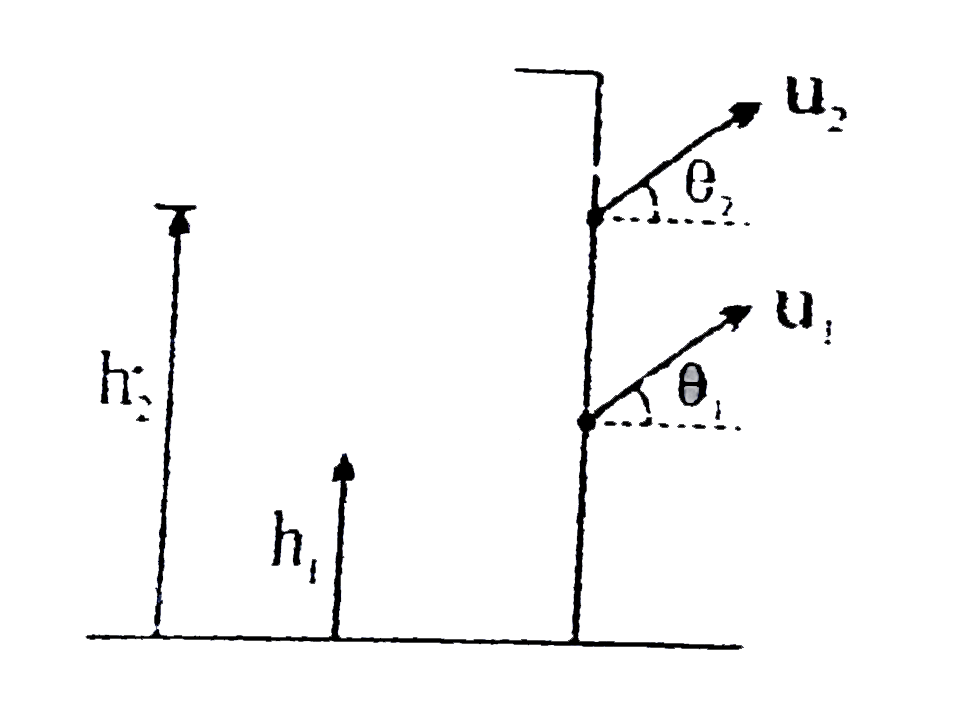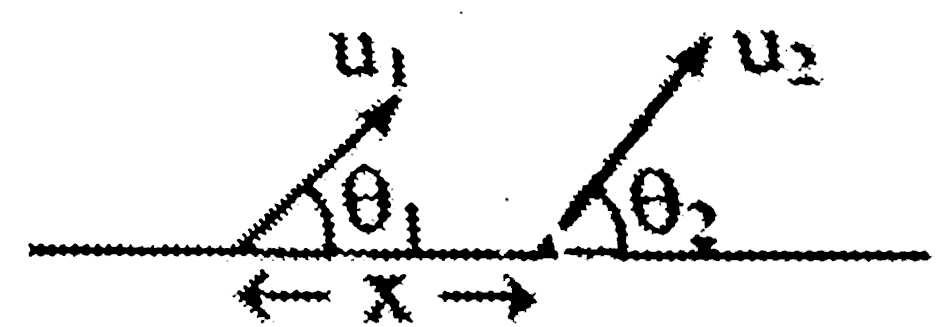Two stones are thrown in same verticle plane from different floors of the same building simultaneously so as to hit the ground simultaneously. Statement-1: They may collide in air.
Statement-2: The two stones may have been projected with same horizontal component of speed.
Statement-1 is true, statement-2 is true and statement-2 is correct explanation for statement-1.
Statement-1 is true, statement-2 is true and statement-2 is NOT the correct explanation for statement-1.
Statement-1 is true, statement-2 is false.
Statement -1 is false, statement -2 is true.
The correct Answer is:D
To strike ground simulaneously
using
using
to collide in mid air x component should be equal relative velocity displcement
time taken
hence cannot collide.

Topper's Solved these Questions
- MASTER PRACTICE PROBLEMBook:BANSALChapter:MASTER PRACTICE PROBLEMExercise:Multiple objective
Explore 131 Videos
- MASTER PRACTICE PROBLEMBook:BANSALChapter:MASTER PRACTICE PROBLEMExercise:Subjective
Explore 107 Videos
- MASTER PRACTICE PROBLEMBook:BANSALChapter:MASTER PRACTICE PROBLEMExercise:Comphrehension
Explore 134 Videos
- FLUID MECHANICSBook:BANSALChapter:FLUID MECHANICSExercise:PYQS AIEEE
Explore 10 Videos
- SEMICONDUCTORSBook:BANSALChapter:SEMICONDUCTORSExercise:CBSE Question
Explore 32 Videos
Similar Questions
Two bodies are projected at angle of 45∘ and 60∘ with the horizontal with same velocity simultaneously. Ratio of their horizontal range is.
View SolutionTwo bodies of masses M and m are allowed to fall from the same height. If air resistance for each body be same, will the two bodies reach the ground simultaneously ?
View Solution
Knowledge Check
Two particles are projected simultaneously from the level ground as shown figure. They may collide after a time :
 Axsinθ2u1Bxcosθ2u2Cxsinθ2u1sin(θ2−θ1)Dxsinθ1u2sin(θ2−θ1)
Axsinθ2u1Bxcosθ2u2Cxsinθ2u1sin(θ2−θ1)Dxsinθ1u2sin(θ2−θ1)Two stones of different masses are dropped simultaneously from the top of a building
ASmaller stone hit the ground earlierBLarger stone hit the ground earlierCBoth stones reach the ground simultaneouslyDWhich of the stones reach the ground earlier depends on theTwo partides. are thrown from the same point in the same vertical plane, as shown in figure simultaneously. Then indicate the correct statements :
 ATime of flight for B is less than that of ABProjection speed of B is greater than that of ACHorizontal component of velocities of B is greater than that of ADThe vertical component of velocities of both A and B are always equal throughout the duration for which both the particles in air
ATime of flight for B is less than that of ABProjection speed of B is greater than that of ACHorizontal component of velocities of B is greater than that of ADThe vertical component of velocities of both A and B are always equal throughout the duration for which both the particles in air
Two bodies of masses M and m are allowed to fall from the same height . If air resistance for each body be same , will the two bodies reach the ground simultaneously ?
View SolutionTwo bullets are fired simultaneously, horizontally and with different speeds from the same place. Whch bullet will hit the ground first?
View SolutionTwo stones are thrown from top of tower, one vertically upward and other downward with same speed. Ratio of velocity when they hit the ground is:
View SolutionAssertion:- Two stones are simultaneously projected from level ground from same point with same speeds but different angles with horizontal Both stones move in same vertical plane. Then the two stones may collide in mid air.
Reason:- For two stones projected simultaneously from same point with same speed at different angles with horizontal, their trajectories must intersect at some point except projection point.
View SolutionIf a stone and a pencil are dropped simultaneously in vacuum from the same height, which of the two will reach the ground first?
View Solution